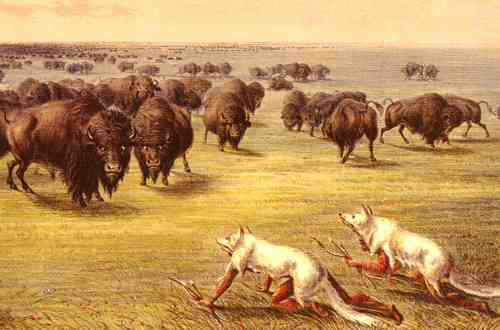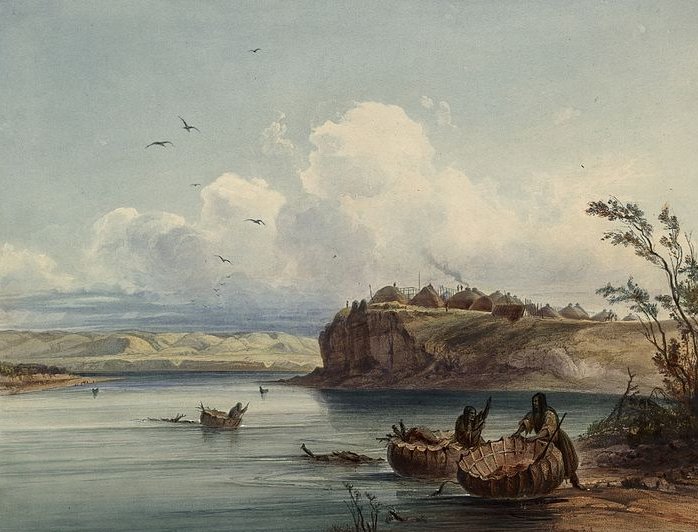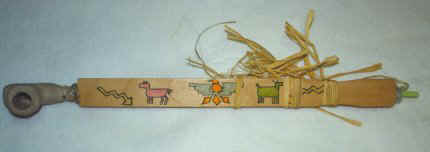Plains Indigenous Peoples
Diet and Agriculture

Hunters
The Plains Indigenous peoples hunted buffalo and other game, such as elk and antelope. To capture them, they would surround the herd or try to stampede the herds off cliffs or into areas where they could be killed more easily. Life for the Plains Indigenous peoples was much easier after they acquired horses. They hunted with bows and arrows even after European traders brought guns. They hunted all year long. Because the buffalo was so plentiful, the hunters were not limited in how many buffalo they killed. The buffalo was roasted over a fire, dried in the sun, made into jerky, and made into pemmican. Pemmican was made by pounding dried meat into powder and mixing it with melted fat and berries. The Plains Indigenous peoples ate berries, cherries, wild greens, camas roots, and wild prairie turnips with the meat.
Cultural Practices
Great Spirit or Wakan Tanka
The Plains Indigenous peoples believed in the Great Spirit. They believed the Great Spirit had power over all things, including animals, trees, stones, and clouds. The earth was believed to be the mother of all spirits. The sun also had great power because it gave the earth light and warmth. The Plains Indigenous peoples prayed individually and in groups. They believed visions in dreams came from the spirits. The medicine man or shaman was trained in healing the sick and interpreting signs and dreams.
Vision Quests
When a boy becomes a man, he seeks a spirit that will protect him for the rest of his life. First, the boy went into the sweat lodge. Inside the lodge, stones were heated, and water was poured over them to produce steam. The boy prayed as the hot steam purified his body. After the sweat lodge, the boy jumped into cold water. Next, he was taken to a remote place and left without food and water. The boy wore only his breechclout and moccasins. The boy prayed for a special vision for the next three or four days. The tribe's men came to help the boy back to the camp. After cleaning up and eating, the boy was taken to the shaman, who interpreted his vision. Sometimes, the boy was given an adult name based on the vision. After the shaman interpreted the dream, the village had a feast to celebrate the boy becoming a man.
The Sun Dance
The Sun Dance was a very important ceremony among the Plains Indigenous peoples. It lasted for several days. Before the ceremony, they would fast. The camp was set up in a circle of teepees. A tree was cut and set up in the center of the space for the dance. Ropes made of hair or leather thongs were fastened to the top of the pole. Men tied these ropes to sticks stuck through the flesh of their chests or backs. The men danced, gazing at the sun, whistling through pipes, and pulling back on the ropes until the sticks tore through the flesh.
Tools, Weapons, and Utensils

Bullboats
The buffalo was very valuable to the Plains Indigenous peoples. The buffalo meat was dried and mixed with marrow and fruit to become a food that would keep for long periods. They used hides to make ropes, shields, and clothing. The teepee was also made from buffalo hide. Sinew or muscle was used to make bowstrings, moccasins, and bags. The bones were used to make hoes and runners for dog sleds. The horns were made into utensils such as spoons, cups, or bowls. Even the hair could be made into rope.
The Plains Indigenous peoples used a parfleche to carry their possessions. It was made from buffalo hide. The hide was cut into a large rectangular shape. Belongings were placed in the center of the hide. Next, the hide was folded like an envelope and tied with rawhide straps. The parfleche was made waterproof by covering it with a glue made by boiling the beavers' tails.
Art and Craftsmanship

Peace Pipe Craft
The artists of the Plains Indigenous peoples used buffalo hides for their artwork. The hides were made into clothing, houses, beds, shields, belts, moccasins, and folded envelopes used for storage, called parfleches. These objects were painted or beaded in geometric patterns. Stripes, diamonds, crosses, arrows, hourglass shapes, thunderbirds, stars, and hunting scenes were often used.
The Plains Indigenous peoples carried bags containing animal and bird skins, pipes, dried herbs, and tobacco. They believed these objects had special powers. Two of the most important bundles were the pipe and beaver bundles. The beaver bundle always contained the skin of a beaver along with the skins of other animals. Some had feathers of birds, rattles, and other objects. The bundles were used in healing and opened at certain times, such as when the first thunder was heard in the spring. The pipe bundle contained tobacco to be used in pipes.